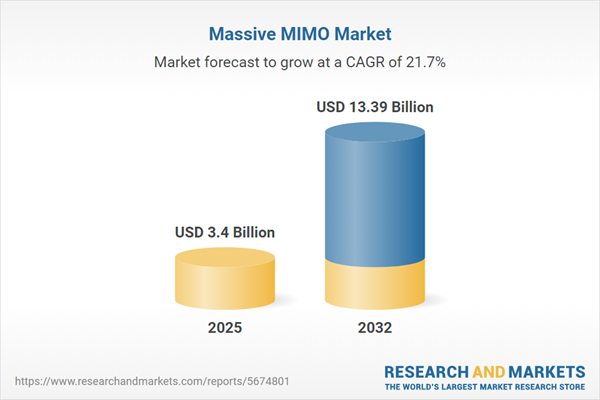Speak directly to the analyst to clarify any post sales queries you may have.
Massive MIMO is increasingly pivotal in modern wireless network evolution, fundamentally reshaping capacity, efficiency, and deployment models for operators and enterprises worldwide. With rising global investment and shifting operational strategies, understanding the landscape of massive MIMO markets is essential for effective decision-making.
Market Snapshot: Growth Trajectory and Investment Momentum
The Massive MIMO Market is witnessing sustained global expansion, underscored by steady year-on-year growth and a robust compound annual growth rate through the forecast period. This surge is driven by escalating demand for enhanced connectivity, densification of urban deployments, and the proliferation of next-generation applications across public and private network contexts. Senior decision-makers are moving quickly to capitalize on new monetization avenues, as flexible spectrum management and advanced antenna architectures position massive MIMO as a core enabler in network modernization programs.
Scope & Segmentation: Comprehensive Coverage of Market Dimensions
- Application Areas: Includes all major domains such as 5G Network (Standalone, Non-Standalone), Fixed Wireless Access for both Enterprise and Residential, and Private LTE5G with specialized deployments in campus and industrial environments.
- Deployment Models: Covers Hybrid, On-Premise, Private Cloud (Managed and Virtual), and Public Cloud (IaaS, PaaS, SaaS), allowing tailored integration, control, and cost strategies.
- Component Types: Differentiates between Hardware (Antenna, Baseband Unit, Cables & Connectors, Filters & Duplexers, Radio Frequency Unit) and Software (Network Management Software, Protocol Stack, Radio Resource Management).
- End-Use Industries: Addresses sectors such as Energy & Utilities, Enterprise (including Healthcare, Manufacturing, Retail), Government & Defense (Defense, Public Safety), Telecom & IT (Network Operators, Service Providers), and Transportation & Logistics.
- Frequency Bands: Encompasses both MmWave (28 GHz, 39 GHz) and Sub-6 GHz bands (2.6 GHz, 3.5 GHz, 4.9 GHz) to match varying coverage and capacity needs.
- Antenna Configurations: Focuses on a range from 64T64R, 128T128R, to larger architectures like 256T256R and 512T512R for extreme spatial multiplexing.
- Regional Analysis: Detailed segmentation includes Americas (North America: United States, Canada, Mexico; Latin America: Brazil, Argentina, Chile, Colombia, Peru), Europe, Middle East & Africa (core regions and key nations), and Asia-Pacific (including China, India, Japan, Australia, South Korea, and other leading markets).
- Competitive Landscape: Examines strategies from major vendors such as Huawei Technologies, Ericsson, Nokia, ZTE, Samsung, Fujitsu, NEC, Cisco, CommScope, and Ciena.
Key Takeaways: Actionable Insights for Decision-Makers
- Disruptive advances in radio hardware and software are enabling adaptable deployments, supporting enterprise, industrial, and public network ambitions.
- Adoption of modular design and disaggregated architectures reduces vendor lock-in and boosts system flexibility, driving operational efficiency.
- Private network initiatives and fixed wireless offerings are pushing re-evaluation of legacy business models, requiring tailored ecosystem strategies.
- Organizations are prioritizing software-driven performance enhancements and incremental upgrade paths, leveraging intelligence to optimize network assets.
- Regional nuances—from regulatory frameworks to spectrum allocation—require careful adjustment of procurement, certification, and go-to-market strategies, especially in high-growth Asia-Pacific and evolving EMEA landscapes.
- Collaboration among hardware suppliers, software vendors, and integrators is essential for seamless, future-proof massive MIMO deployment.
Tariff Impact: Navigating Supply Chain and Sourcing Shifts
New U.S. tariff regimes are reshaping procurement by intensifying focus on supplier diversification, geographic risk evaluation, and component-level flexibility. Organizations are consolidating risk through multi-region supplier networks, software-agnostic integration, and detailed lifecycle planning. Tariff changes drive not only hardware cost management, but also accelerate the shift toward modular and software-oriented network solutions, fostering greater resilience in both deployment and operational support.
Methodology & Data Sources
This report is underpinned by a rigorous mixed-method approach: primary engagement with industry stakeholders, technical literature review, and scenario-based analysis. Extensive interviews, workshops, and secondary research into current standards and regulatory documentation ensure accuracy and practicability.
Why This Report Matters
- Enables data-driven investment and procurement planning, integrating market trends and vendor strategies for optimal organizational outcomes.
- Equips leaders with region- and sector-specific guidance to navigate emerging risks and capitalize on new business models in massive MIMO adoption.
- Provides actionable frameworks for accelerating network modernization while mitigating operational and supply chain risks.
Conclusion
Strategic choices in modularity, software optimization, and supplier diversification will define leadership in the evolving massive MIMO space. This report empowers decision-makers to make informed, resilient moves as the market continues to mature.
Additional Product Information:
- Purchase of this report includes 1 year online access with quarterly updates.
- This report can be updated on request. Please contact our Customer Experience team using the Ask a Question widget on our website.
Table of Contents
3. Executive Summary
4. Market Overview
7. Cumulative Impact of Artificial Intelligence 2025
List of Figures
Samples

LOADING...
Companies Mentioned
The key companies profiled in this Massive MIMO market report include:- Huawei Technologies Co., Ltd.
- Telefonaktiebolaget LM Ericsson
- Nokia Corporation
- ZTE Corporation
- Samsung Electronics Co., Ltd.
- Fujitsu Limited
- NEC Corporation
- Cisco Systems, Inc.
- CommScope Holding Company, Inc.
- Ciena Corporation
Table Information
| Report Attribute | Details |
|---|---|
| No. of Pages | 197 |
| Published | October 2025 |
| Forecast Period | 2025 - 2032 |
| Estimated Market Value ( USD | $ 3.4 Billion |
| Forecasted Market Value ( USD | $ 13.39 Billion |
| Compound Annual Growth Rate | 21.6% |
| Regions Covered | Global |
| No. of Companies Mentioned | 11 |









